
The Shoah and the Second Generation:
Second Generation Trauma:
The Post-Holocaust Experience

 |
The Shoah and the Second Generation:Second Generation Trauma: |
 |
| Click here for a printable version of this hypermedia project. |

Regardless of whether the Holocaust literature author experienced the horrors of the event first-hand or inherited the pain through kinship bonds, the survivor character is seldom a perfect, heroic figure. Narratives tend to resist the urge to deify this personage; usually depict these individuals as "tainted and haunted," the result of unspeakable evils and sheer good luck in escaping the fate that six million others did not.1
Contrary to the popular maxim, the strong were not the ones who survived the Holocaust, a matter that puzzles humanity, survivors, and their children alike. During the conversations with his father, Spiegelman struggles to comprehend why Vladek, a man full of imperfections, escaped death while others--presumably better than he--did not. Spiegelman is baffled by this occurrence, and questions his psychiatrist. Himself a survivor, Dr. Pavel attempts to comfort Art by explaining that even those who experienced the camps are unable to concoct an acceptable explanation--an unmistakable legacy of the unexplainable nature of Auschwitz.

This inability to comprehend, although shared with actual survivors, is a main component of the lives and efforts of the second generation. In many cases, these intricacies impede flawless adherence to factual evidence, forcing the author to rely on interpretation and reminisces to compose his/her work. These accounts, however, possess historical value, despite not being first-hand accounts of the Shoah. Their real strength lies in "recording the psychological and emotional milieu of the struggle for survival."2 This sentiment is shared by Charlotte Delbo, a French Holocaust survivor who stated "je ne suis pas sûre que ce que j'ai écrit soit vrai, mais je suis sûre que c'est véridique" (I am no longer sure that what I have written is sure, but I am sure that it happened.)3
Art encounters this problem as Vladek's memories are triggered by inter-connected remembrances, and as such often result in broken episodes. His frustration is evident in the panel above, as Vladek jumps from the beginning of the war to the latter stages, a result of painful connections and a desire (conscious or unconscious) to block particular incidents from his memory. A similar episode occurs later as Vladek is unable to recall to which camps some of his acquaintances were destined.
Given that flawless chronological order is quite difficult for the actual survivors, the task of grouping events in accordance to their actual occurrence is perhaps impossible for the second generation. Therefore, their methods of remembrance--literary, musical, or dramatic--should not be diminished for this fault. Instead, they should be praised for their adherence to the original source. Allowing the source to remain unaltered, even if it results in a disjointed narrative, retains the native feeling and emotion of the survivor's pain and experience.
It is precisely this faithfulness to the original source that reflects the post-Holocaust trauma, experienced by survivors and their children alike. A well-documented psychological phenomenon, the post-Holocaust syndrome affects in divergent fashions and varies in intensity. However, as Alan Berger has pointed out, "not all are physically damaged, but all have been touched by the Shoah."4. Survivors are scarred by their incident, and their children feel both the pain and the need to remember, even if the event predates them.
Not surprisingly, the expression of mourning is central in the life of survivors.5 These effects are inevitably transmitted by one generation to another, in the process passing both a right and an obligation to address the issue. This, however, proves to be a "solemn task", since the "children of survivors lack direct access to the Holocaust," as Art expresses in the panel above.6 Bosmajan has written that the "child of survivor has no iniquity, and as a result, no authority."7 Despite this barrier, most children of survivors cannot avoid the event that has shaped their lives. While they have not experienced it, they are nonetheless compelled to pay homage to those who did, and come to terms with the consequences that the Holocaust creates in their lives. However, the lack of direct access presents problems such as the incapacity to settle on proper representation, and the ubiquitous post-Holocaust syndrome.
The previous sections have touched upon Art's attempt to deal with grief, channeled through Maus and Prisioner on Hell Planet, which contrast with his father's method, centered on the repression of emotions and remarriage after Anja's death. The novel contains many other instances in which Art is shown afflicted by the post-Holocaust trauma, most notably in conversations with his wife Françoise, as exemplified below.
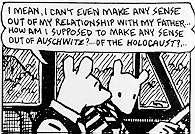
|
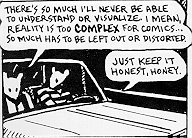
|
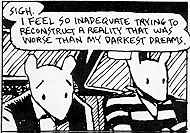
|
Painted as a sequence intent on self-examination and meditation, Art presents the common traits of post-Holocaust syndrome, as he questions his ability to come to terms with the Shoah. Unable to grasp the concept on a larger scale, he turns to a much-smaller element that also eludes him: the relationship with Vladek. Products of divergent epochs, father and son are often at odds; their personalities are quite different. Art's attempt to grow closer to his father by initiating a dialogue on the root of their respective pain (the post-Holocaust syndrome) is obstructed by their inadequate and difficult rapport.
During the same conversation, Art once again displays a preoccupation with his quest. Born after the war, he feels his separation from the Holocaust is impairing the creation of his work, as well as enlarging the abyss that exists between his father and himself. Singling out "reality," he addresses one of the main dilemmas behind his quest. Spiegelman feels inadequate trying to express his sorrow and his father's history through the comic medium, his natural art channel. In spite of being a professional artist and recognizing the genre's ability to represent such mature topics, he remains unconvinced of his chosen method's capacity to transmit the pain.
This torn nature showcases the difficulties found in the children of survivors' lives, who number 250,000 in the United States alone.8 Their own desire to commemorate is met by limitations, even though some channel their emotions through artistic inclinations. The Internet, for example, has eased the diffusion of some of these works. Some have turned to film; others such as Blue Greenberg, poetry; and there are even some who have chosen photography. The bond of communal and ethnical suffering links the group, regardless of the vehicle diffusion.

In addition, other symptoms can be found, such as the presence of "ghosts siblings" (those who perished during the Holocaust) and their idealized views. Survivor parents often expected children born after the Liberation to "replace offspring" who account among the six million victims.9 Sandra Williams agrees, as she states these new kids were "expected to be representatives and/or reincarnations of those lost," forcing them to "live their own existence, and also those of their dead siblings."10 The panel illustrates the sentiment, as Art is continually reminded of a brother he never knew, the source of competition he loathed. This friction, however, does include a hint of respect and compassion, demonstrated by the second volume's dedication to Richieu.
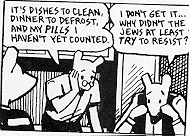
Another element ubiquitous in the narrative is the inability to fully comprehend the Holocaust; that is, Art fails to "get it" despite his best efforts. Josuha Brown notes that "the dilemma of not knowing pervades the book," as exemplified by the panel to the right.11 After listening to Vladek's retelling of the mass cremations, Art can only ask questions and state he "doesn't get it." The Shoah, so far removed in some instances and so close in others, provides a formidable challenge to human reasoning and understanding, and an even stronger one for Art and his second generation counterparts, who did not experience the horrors firsthand.
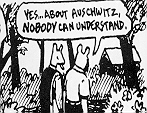
"An enigmatic paradigm" is how author Helen Epstein describes the Holocaust.12 Haunted by the event, as a child she would ask about the fate of her grandmother. Being told that the Nazis had murdered her confused the girl, as she was unable to grasp why Hitler's regime would annihilate an entire race--something many others still find unbelievable. This lack of comprehension is also found in the survivors themselves, as Vladek attempts to comfort Art by saying, "about Auschwitz, nobody can understand."

This incapability to comprehend is also present in the exchanges between father and son. In the panel shown at left, Art is surprised Vladek does not remember what happened to a particular acquaintance. The latter, however, lessens the importance of remembering the fact, instead opting to point out that the end result was the same: "either way, they killed him." Recalling the actual event is not of utmost importance, since the end result is identical in most cases.
The above mentioned elements combine to create an overwhelming sentiment among children of Holocaust survivors. Being molded by the Holocaust, these "children feel they have a mission".13 This quest, in turn, can become an artistic endeavor, as is the case with Spiegelman and Maus. In a 1992 interview, Art stated that composing Maus "filled the more central need for me of trying to make sense of my own personal and of history as I intersected with it."14
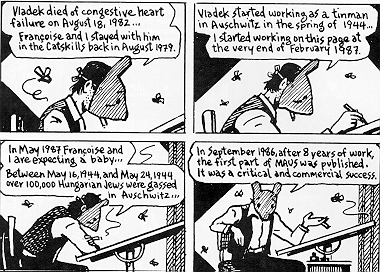
While this is a noble quest, it does present some problems. Epstein asks rhetorically, "how do you beat Auschwitz? How do you beat that story?"15 In that sense, children of survivors can be categorized in two groups: those who have realized their lives are different from their parents, and as such, "beating the Holocaust" is unnecessary; and those who continue to feel inadequate even after coming to terms with such a realization. Both factions share a common bond: they have made an attempt to channel their emotions, often through cathartic outlets.
In a section devoted to reflection and meditation, Art juxtaposes events in his life with those of his father. More than a competition, the contrast represents a statement of conscience; written after a period of self-evaluation, it affords both the author and the audience a chance to reflect. Featured as calm moment amidst a sea of tormentous pain, it informs the reader of the events that transpired from 1970 to 1987, ranging from the happy (birth of Spiegelman's daughter) to the painful (Vladek's death).
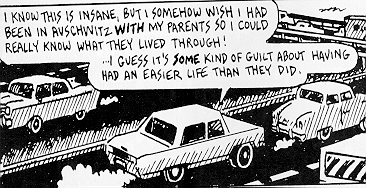
In addition, the episode above is written after the conversation between Art and Françoise that begins the second volume. In that particular scene, Art feels unprepared for the task of writing Maus, mentioning his guilt for "having had an easier life that they did." He showcases the common symptoms of the post-Holocaust syndrome, intensified by the fact that he is caught in the middle of his quest, damaged by his troubled relationship with Vladek and the ghosts of the Holocaust.
The second generation, thus, feels inadequate to represent the pain, but must find a way to commemorate. This quest is the cause of many crises such as Art's, but it also succeeds in bringing the children of survivors to terms with some of their demons.
| Introduction |
Graphical Representation: The Unusual Structure of Maus |
| Father and Son: Maus's "Story Within the Story" | Conclusion and Bibliography |